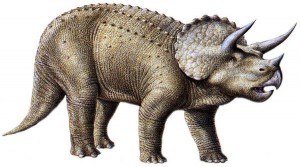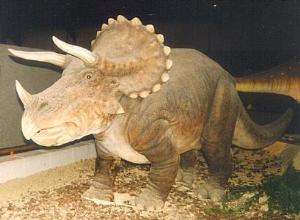Triceratops Facts
One of the most well-known dinosaurs, the triceratops was a herbivorous titan that was very well equipped for a fight.
Triceratops is a genus of herbivorous dinosaur that comprises two validated species – triceratops horridus and triceratops prorsus, both of which roamed Earth during the Late Cretaceous period (68-65 Ma) before being eradicated in the K-T mass-extinction event that wiped out all dinosaurs.
Triceratops were large, rhinoceros-like animals that weighed many tons – a fully grown adult would be expected to weigh in the region of seven tons.
They were heavily armoured with reinforced bone horns, which could exceed 70 centimetres (28 inches) and a solid bone frill, and hugely powerful thanks to their sturdy frame. 
These traits, combined, made both species of triceratops a fearsome foe to potential predators, capable of puncturing flesh and shattering bone with their sharp horns when charging.
In terms of anatomy, the triceratops genus is incredibly interesting, not least because many of its parts’ functions are still debated today in the field of palaeontology.
A good example of this can be seen by analysing a typical triceratops skull, which -aside from typically measuring a whopping two metres (6.6 feet) in length – sported three horns as well as a fluted, extravagant rear frill.
 The horns, from which the genus gets its name, and frill have been successfully argued by palaeontologists to have been used for self-defence against predators, with close examination of unearthed specimens revealing battle scars, cuts, punctures and cracks. However, modern scholars also postulate that both skull features, along with the elongated nature of the skull itself, most likely also evolved as courtship aids, with potential mates selected on the size and shape of these features. It has also been suggested that the frill may have helped triceratops regulate their body temperature in a similar manner to the plate-laden stegosaurus (whose name translates as roof, or covered, lizard).
The horns, from which the genus gets its name, and frill have been successfully argued by palaeontologists to have been used for self-defence against predators, with close examination of unearthed specimens revealing battle scars, cuts, punctures and cracks. However, modern scholars also postulate that both skull features, along with the elongated nature of the skull itself, most likely also evolved as courtship aids, with potential mates selected on the size and shape of these features. It has also been suggested that the frill may have helped triceratops regulate their body temperature in a similar manner to the plate-laden stegosaurus (whose name translates as roof, or covered, lizard).
Other anatomical areas of interest lie in this dinosaur’s large bird-like beak and hips. Indeed, it is because of these particular features that this genus has been used as a reference point in the definition of all dinosaurs – ie all dinosaurs are descendants of the most recent common ancestor of triceratops and, as such, this common ancestor is also that of birds prevalent throughout the world today. It’s important to note here that modern birds did not descend from triceratops directly, but rather from its common ancestor with all other dinosaurs; today’s birds in fact originate from saurischian dinosaurs.
 The fundamental diet of the triceratops was largely dictated by- and most likely co-evolved with – its low-slung posture and head position, which was located close to the ground. As a consequence of these factors, as well as its deep and narrow beak and sharp teeth batteries, both species of triceratops most likely consumed large amounts of low-growth ferns, palms and cycads, plucking the plants with their beaks and then shredding the fibrous material with their teeth.
The fundamental diet of the triceratops was largely dictated by- and most likely co-evolved with – its low-slung posture and head position, which was located close to the ground. As a consequence of these factors, as well as its deep and narrow beak and sharp teeth batteries, both species of triceratops most likely consumed large amounts of low-growth ferns, palms and cycads, plucking the plants with their beaks and then shredding the fibrous material with their teeth.
The triceratops’ main potential predators were carnivorous theropod dinosaurs such as the tyrannosaurus rex. However, while modern-day depictions of these two prehistoric titans are often far-fetched, triceratops specimens have been discovered with T-rex bite marks and even one where the herbivore had had one of its brow horns snapped off entirely.
